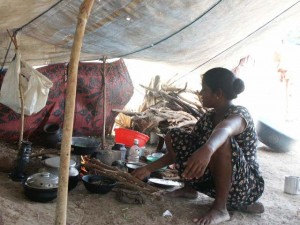What Happens To My Reproductive Choice In A Conflict Zone
Before you begin to read this blog, take a look at this short video:
This is what Sana Contractor and Siddarth David of CEHAT asked us to think about at CEHAT’s recent Post-Graduate Course for Health and Human Rights. As the very nature of conflict changes from armed wars fought between nations to chemical warfare aimed at ethnic groups within the country or to economic battles fought in capitalistic markets, it has become very important to ask ourselves how these conflicts affect women. How is their access to resources — already limited by patriarchal societies — further curtailed by conflicts? Can these women see a doctor when they are sick? Can they choose if and when to become a mother?
History has showed us that women in conflict zones suffer two fold: from the direct lack of resources, and as Siddarth put it, “from the changes in the fabric of the society” subject to these clashes.
The direct lack of resources is more obvious and therefore easier to understand. In conflict zones, women have very little access to health care, particularly maternal health simply because of the lack of adequate infrastructure, or due to a death of man power. Women in remote areas have been forced to brave shelling, landmines and military vigilance to reach a hospital. Those who cannot do so, are left in the care of traditional birth attendants, who even if adept might not be able to handle extremely complicated cases.
A woman’s life in a conflict zone is rendered even more complicated by the more insidious consequences of armed violence: the rise of masculinities and the resurgence of religious fundamentalism. Conflict zones have historically witnessed an increase in violence against its women, and in response women’s mobility and freedom is curtailed within patriarchal societies. Religious fundamentalism has also played a role in curtailing a woman’s autonomy and control over her fertility.
Abortion in conflict zones is very complex issue. There is no doubt that abortion is a very basic service for women in conflict zones. The increase in sexual violence against women is usually accompanied by a rise in unwanted pregnancies. Mothers can also choose to have an abortion if they fear for the safety of a child, even if the pregnancy happens within wedlock. An increase in war rapes have prompted some governments to liberalize or decriminalize abortion. International covenants and committees have also pushed governments to allow women to abort their unwanted pregnancies, specifically when they result from rape.
But there is also an equal amount of resistance to the liberalization of abortion within conflict zones mostly because conflicts usually promote religious conservatism and hyper-masculinities. Both these ideologies endorse the view that a woman is a future mother, and so prompt the society to take away her agency to decide if and when she wants to become a mother.
Access to health care, including abortion, is restricted because of another reason: doctors are often unwilling – for security reasons – to practice within conflict zones. This lack of trained practitioners leads to an increased number of women risking unsafe abortion to get rid of unwanted pregnancies. In areas where the conflict spawns from communal or ethnic disagreements, doctors might be unwilling to treat women from certain minority groups either for the fear of persecution, or from personal biases.

While these problems have been discussed several times, it is harder to quantify them and harder still to come up with solutions. But at the workshop last week, we came up with two possible solutions to issues of health care.
Braj Ghosh, a graduate student in Public Health at SRM Medical College, Tamil Nadu suggested that doctors should be trained in disaster management and in handling emergencies within conflict zones. “It is hard to imagine that among so many doctors not one wants to go and work in such an area. I think that they must be trained to protect themselves and handle patients in conflict zones,” he said. Medicine San Frontiers is an excellent example for an organization that trains doctors to serve communities caught in such zones.
Along with training doctors to deal with the tensions of conflict zones, it is important to adapt medical technology that can be used in such situations. For women seeking abortion, access to medical abortion can also be an excellent solution within conflict zones, particularly those where religious fundamentalism might put the woman’s life in danger if her intentions for visiting a local doctor are made known.
It is also important to realize that conflict zones might need a different form of health care than that is offered elsewhere within any country. For example, institutionalized health care might be a barrier to women in areas where violence restricts their mobility. In such cases, task shifting – the process by which midlevel providers are trained to perform a doctor’s task – might offer relief to patients who live in areas with little or no institutionalized care. Also, a traditional birth attendant might be more willing to stay back with her community during times of conflict than a doctor might be. If trained, she can also provide safe abortions.
Where people find it difficult to travel to hospitals, the government and civil societies will have to work together to take health care to the people.






